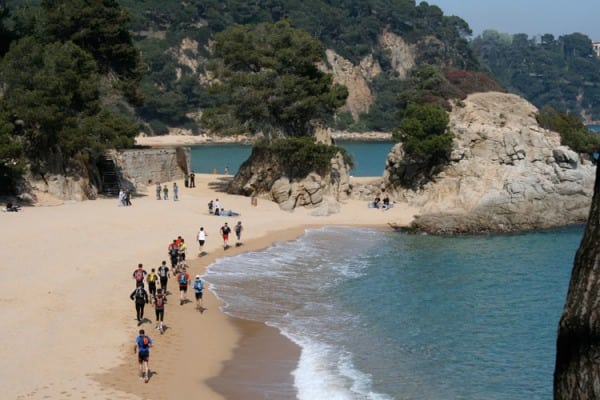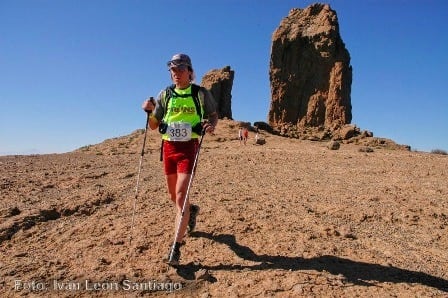Trail Running in Spain
by Ed Martinell of TrailRunningSoul.com and Traiectus, a group that leads trail running tours in the Pyrenees and Spain’s Costa Brava
The Scene
Although trail running is not as popular as road running (for now), trail running has a long history in Spain. Between 1923 and 1925, a series of mountain races known as the “Iron Cup” were run while in 1928 the “March of the Three Refuges,” a race of about 25Km, was held in the Sierra de Guadarrama, Madrid. However, it has been in the past 20 years that mountain racing has solidified due to race continuity and outstanding organization.
Spain is a country known for its love for mountain climbing and everything surrounding the mountain world. The Pyrenees and other major formations throughout the country have influenced many aspects of sports. And running is no exception. That explains why there is no “trail running” in Spain. Instead, there is “mountain running” or “mountain racing.” Accordingly, many of the competitions are held at high elevations in the mountains. However, little by little, the popularity of what others call “trail running” is growing, as more and more runners opt for any type of off-road terrain from forest trails to back country roads to coastal trails. Thus, “trail running” may be a fitting name for the sport given the evolution of the sport within Spain.
The Runners
Spain has a long tradition in long distance running with great Olympic athletes and marathon specialists. “Off road” running is no exception. We all already know Kilian Jornet, double winner of the Ultra-Trail du Mont-Blanc, among many other mountain victories, but there are other great runners with similar international renown. The Skyrunner World Series has seen the likes of Mireia Miró, Tòfol Castanyer, and Agustí Roc. Spaniards have also fared well in “adventure” ultramarathons, such as Salvador Calvo in the 4 Deserts, Sergio Fernandez at the Libyan Challenge, and Jorge Aubeso at the Marathon des Sables. Many other Spanish runners have recorded outstanding results at trail events of all kinds.
The Races
There are many trail races and championships held in Spain throughout the year. They range from as short as 2Km (1.25 miles) up to stage races longer than 250Km (155 miles).
The official mountain racing championship series organized by FEDME (Spanish Federation of Mountain Sports and Climbing) represents the greatest title you can earn as a trail runner in Spain. It includes 6 races held during the year with races distances of around 30Km (18.5 miles) and always with an important climb to overcome. Another competition worth noting is the GORE-TEX Series – Vertical Running, which includes two events containing a vertical kilometer climb over a distance of between 2 and 5Km (3 miles) and the grand finale up the Collserola Tower, Barcelona, in which runners climb the tower’s 115m (377 ft) of stairs.
While short trail races are alive and well in Spain, ultramarathons are seeing the greatest growth in number and popularity. Such races are often called “ultra trail,” after a barely known race in the Alps. ;-) Ultra trails often take place in mountainous terrain which, with distances up to 200Km, are capable of bringing together crowds of runners. Here is a small sample of Spain’s ultramarathons:
Ultra Trail Aneto: 64Km (40 miles) and 3,700 meters (12,140 feet) of vertical drop that takes the competitors around the highest peak in the Pyrenees, Pico Aneto.
Transgrancanaria: 123Km (76 miles) and 7,000 meters (23,000 ft) on a course where runners attempt to cross Grand Canary island within the 30 hour cut off time.
Al Andalus Ultimate Trail: 230Km (142 miles), 5 day stage race through Andalusia in mid-summer with hot temperatures in the 35-40C (95-104 F) range.
Costa Brava Challenge: 100 or 200Km (62-125 miles) in 3 days that follows the coastal Costa Brava trails formerly used by smugglers.
These are just a small sampling of the many events held in the country. In addition, Andorra (Andorra Ultra Trail) or the French Pyrenees (Le Grand Raid des Pyrénées) have other important events affordable (by proximity) to those staying in Spain.
The Trails
Spain is a country well suited for visiting trail runners. Is has good communications, is tourist friendly and, at the same time, has a wide variety of trail running environments from snowy mountains to coastal areas, extensive forests and national parks, large areas in near-desert conditions or even volcanic environments. One advantage is that the entire territory is traversed by an extensive network of trails that allow you to reach into almost every corner. Although not all trails are properly maintained, many are part of the European network of trails GR (long footpath), which means they are well mapped and will guide you relatively easily through the most beautiful spots.
These are some of the best places to enjoy the Spanish trails:
Pyrenees:
This mountain range that separates Spain and France is the ideal place to enjoy trail running in the mountains. 415Km (260 miles) from coast to coast means a lot of trails! With a maximum elevation of 3,404m (11,168 ft) at Aneto and many peaks above 3,000 m (9,000 ft), there are many fantastic areas high elevation runs.
In spring and summer, a network of huts offer an endless set of possibilities for running through beautiful montane and alpine settings. The trails seem endless. The most famous one is called GR11, which crosses the entire range from the Atlantic Ocean to the Mediterranean Sea. If you prefer some assurance in an unfamiliar area, consider a guided trail running tour (available soon) through the Pyrenees!
Mediterranean Coast:
The regions of Spain’s East Coast are among the most active in terms of mountain races. Its mild climate in both summer and winter and its peoples’ huge love for hiking make it easy to find both inland and coastal trails. Although real estate over-development has damaged many coastal areas, there still exist areas with great beauty. In addition, the local natural parks area abundant with wildlife. If you’re in the area don’t forget to visit the Balearic Islands, which host many events in a very special environment similar to Corsica or Sardinia.
Southern Spain:
Andalusia has a climate closer to a north African region than that of a European one. Temperatures of 40C (104F) in the dry summers, extensive coastal plains and desert areas make it a suitable spot for those looking to run under extreme conditions. Yet it also has mountain trails in the Sierra Nevada and an area of subtropical coastline. You can’t ask for more diversity of trail running terrain in fewer square miles.
Canary Islands:
This volcanic archipelago lies southwest of Europe, but is much closer to the African coast. The Canaries have a pleasantly moderate climate with average temperatures of 25C (77F) all year round. Still, the islands have a range of climates from subtropical to desert/volcanic mountains. Its climate and tourist-friendly orientation make it ideal for active vacations, whether on land or in the water. The different islands hold many extreme events, most notably the Ironman Lanzarote triathlon.
To Wrap Up
Spain is a country in which trail running is booming. That means there’s a steadily increasing number of events, that are more diverse and internationally recognized every year. This, mixed with the fact that it is one of the most important tourist countries in the world (thus, lots of lodging and non-running leisure options), makes Spain a perfect place for a competition or to simply discover the beauty of the country’s trails.
Questions/Comments
Anyone who has run in Spain, either as a local or as a visitor, please share your thoughts on trail running there.
Likewise, if you’re considering taking a Spanish trip that involves trail running, ask away. Hopefully, someone will be able to answer your questions.
[Below is the second article in a series that profiles trail running in various countries around the world. We’ve recruited local experts for each of the articles. Please get in touch if you are interested in helping develop a profile for your country.]



